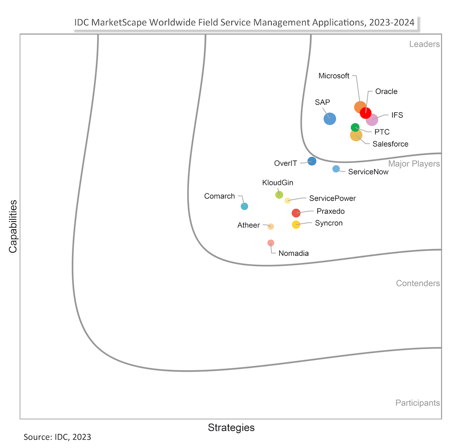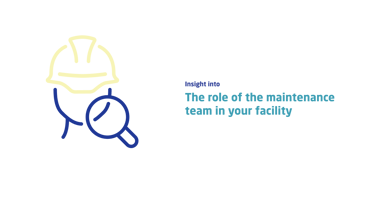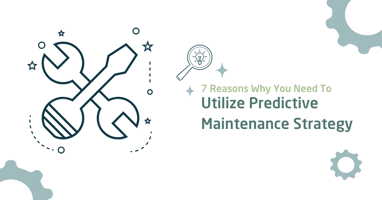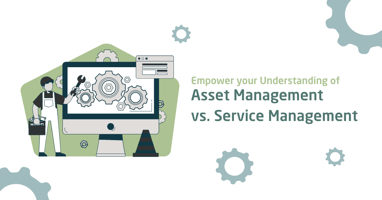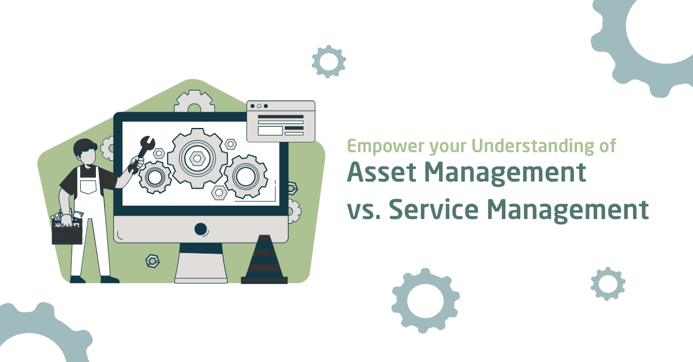
Learn the main differences between asset management and service management and find the best tool for your business.
For any business to thrive, effective management of assets and services is essential.
Every field has its own difficulties and goals, and choosing the best tools for your business can be overwhelming. That's why understanding the differences between asset and service management is crucial. By doing this, you can ensure your organization has the tools to improve operations and achieve goals successfully, and we are here to help you!
KEY TAKEAWAYS
- - Service management involves providing and managing services for customers.
- - Asset management involves managing physical and digital assets to increase their value and performance.
- - Asset management is typically employed across sectors such as manufacturing, energy, construction, mining, water supply, transportation, agriculture, forestry, fishing, and hospitality.
- - Service management finds its relevance in industries like IT, home services (HVAC, plumbing, electrical), telecommunications, healthcare, retail, landscaping, and utilities.
- - In certain scenarios, leveraging both asset management and service management solutions can prove immensely advantageous for organizations.
Understanding Asset Management
Asset management is a discipline that focuses on the strategic management of physical assets throughout their lifecycle. It involves identifying, acquiring, operating, maintaining, and disposing of assets in a cost-effective manner while maximizing their value and performance.
ISO 55000, an international standard providing guidelines and best practices for asset management, defines asset management as "the coordinated activity of an organization to realize value from assets" (ISO 55000, 2014, 3.3.1).
Enterprise asset management (EAM) software enables asset-intensive companies to optimize the value of their assets over their lifespan, concurrently streamlining and reducing costs of maintenance operations and ensuring regulatory compliance.
In many industries such as manufacturing, energy and utilities, construction, mining and quarrying, water supply and remediation, transportation and storage agriculture, forestry, fishing, and accommodation and food services, where the health and dependability of physical assets are pivotal to operational effectiveness and financial success, enterprise asset management software plays a vital role, serving as a tool for effective asset management.
EAM software becomes fundamental through features like:
- Maintenance Planning (corrective, preventive, predictive)
- Work Order Scheduling
- Work Execution
- Maintenance Review
- Compliance management
Use case
Let’s take an example from the Food and Beverage industry.
Company Foody Goodie operates in the highly regulated food and beverage industry, where strict adherence to safety standards and quality control is paramount. With a vast network of production facilities and distribution centers, managing assets effectively while ensuring compliance with food safety regulations can pose many challenges. Manual asset tracking and maintenance processes are time-consuming, prone to errors, and lack real-time visibility into equipment performance. Additionally, unplanned downtime and equipment failures disrupted production schedules, impacting not only product quality but also customer satisfaction.
Let's explore how Foody Goodie can leverage Enterprise Asset Management to address their challenges:
✔️ Improved Equipment Performance
With EAM, Foodie Goodie can continuously monitor equipment performance through sensor technology. This allows for early detection of potential issues, ensuring that machines operate at their optimal levels. By maintaining peak performance, Foodie Goodie can consistently deliver high-quality products to its customers.
✔️ Minimized Downtime
Proactive maintenance scheduling based on real-time data helps Foodie Goodie minimize downtime. By addressing maintenance needs before they escalate into critical failures, production interruptions are minimized. This ensures smooth operations and prevents costly delays, optimizing overall productivity.
✔️ Enhanced Compliance and Safety
EAM software helps Foodie Goodie maintain compliance with stringent food safety regulations. By automating compliance tasks and documentation, the company ensures that all equipment meets regulatory standards. This not only safeguards consumer health but also protects the company from potential legal and reputational risks.
✔️ Streamlined Maintenance Processes
Automation of the work order process streamlines maintenance tasks for Foodie Goodie. By automating task assignment, tracking, and documentation, the company can efficiently manage maintenance workflows. This reduces administrative overhead, improves communication among maintenance teams, and ensures timely completion of tasks.
✔️Predictive Maintenance
The implementation of predictive analytics within the EAM system enables Foodie Goodie to anticipate equipment failures before they occur. By analyzing historical data and performance trends, the company can identify potential issues and take preemptive action. This minimizes the likelihood of unexpected breakdowns, further reducing downtime and maintenance costs.
✔️Cost Savings
By optimizing maintenance schedules, reducing downtime, and prolonging equipment lifespan, EAM delivers significant cost savings for Foodie Goodie. The company can avoid costly emergency repairs, minimize energy consumption through efficient equipment operation, and extend the lifespan of assets through proactive maintenance. These cost savings contribute directly to the company's bottom line.
✔️Improved Customer Satisfaction
Consistently delivering high-quality products, thanks to optimized equipment performance and adherence to safety standards, enhances customer satisfaction. Foodie Goodie's reputation for reliability and product excellence strengthens, fostering customer loyalty and driving repeat business.
Enterprise Asset Management empowers Foodie Goodie to optimize equipment performance, ensure regulatory compliance, streamline maintenance processes, and deliver cost savings —all of which culminate in improved operational efficiency and enhanced customer satisfaction in the competitive food and beverage industry.
The Value of Asset Management for Businesses
For companies in asset-intensive industries, EAM software is more than just a tool for maintenance management - EAM helps with long-term resilience, financial stability, and staying ahead of competitors.
By prioritizing asset reliability, availability, and performance, organizations can better navigate the complexities of their industries and thrive in the face of challenges. EAM software becomes indispensable in these contexts for several reasons:
1. Asset Reliability
EAM systems provide tools and methodologies to predict and prevent equipment failures, ensuring that assets remain operational and reliable. This is crucial in environments where equipment downtime can lead to significant operational disruptions and financial losses.
2. Availability
By facilitating planned maintenance and reducing unscheduled outages, EAM software helps ensure that assets are available when needed. This supports uninterrupted operations and helps maintain productivity levels.
3. Performance Optimization
EAM software enables organizations to monitor and analyze asset performance in real-time, identifying opportunities for optimization and efficiency improvements. This can lead to reduced operational costs and enhanced asset utilization.
4. Lifecycle Management
EAM solutions oversee assets from purchase to removal, making sure they are well-maintained, upgraded, or replaced when needed. This approach maximizes the value derived from each asset and supports strategic capital planning.
5. Compliance and Safety
EAM systems help ensure compliance with industry regulations and safety standards by maintaining detailed records of maintenance activities, inspections, and certifications. This is particularly important in industries subject to stringent regulatory oversight.
Integration between ERP and EAM
Integrating Enterprise Resource Planning (ERP) with Enterprise Asset Management (EAM) is like connecting two puzzle pieces to create a complete picture. ERP is designed to help manage finances and resources, while EAM focuses on ensuring that equipment runs smoothly. When ERP and EAM work together, businesses gain a comprehensive view of their finances and equipment, enabling them to make better decisions.
.jpg?width=704&height=396&name=For%20the%20blog%20(1).jpg)
For instance, businesses can easily identify when their equipment needs maintenance, plan maintenance work without interrupting their operations, and ensure that all their processes comply with regulations.
At Dynaway, our mission is to simplify things for our clients. We help businesses save time and resources through the seamless integration of our EAM solutions with Microsoft Dynamics 365 ERPs. This not only eliminates data silos but also reduces stress and allows businesses to focus on their core operations with ease.
Chris Gerold, the Business Process Owner for EAM at Dairyland Power Cooperative and leader of the successful D365 implementation, emphasizes the importance of considering how ERP implementations impact every aspect of the business:
Understanding Service Management
Service management (SM) can be defined as the strategic approach to overseeing and optimizing the delivery of services that support a business's assets. It is a crucial aspect of ensuring that a product remains competitive in the market - by offering services that are related to other connected products, SM can provide additional value to the businesses and further strengthen their position.
Service Management is usually useful in the context of industries like IT, home services (such as HVAC, plumbing, and electrical services), telecommunications, healthcare, landscaping, and utilities. It focuses on the delivery and management of services that support the organization's assets and aims to ensure that services are aligned with business needs and are delivered efficiently and effectively. This includes:
- Managing work orders,
- Scheduling maintenance services,
- Handling service requests,
- Ensuring service level agreements (SLAs) are met,
- Ensuring timely service,
- Tracking service performance and customer satisfaction.
Service Management is a field that is often closely related to IT assets and infrastructure. However, it can also apply to any service-oriented aspect of asset management, including facilities management and maintenance services.
Managing services can be a challenging task, and it requires a thoughtful approach to ensure that we are meeting customer needs and delivering high-quality services efficiently. This is where Field Service Management (FSM) comes into play, providing a consistent and organized approach to managing services.
Field Service Management
Field Service Management (FSM) is all about catering to the needs of service industries, and it focuses on the management and coordination of services provided by a business.
As described by the International Data Corporation (IDC), Field Service Management encompasses a range of activities to streamline field service operations.The primary aim is to improve the quality and efficiency of services delivered in the field, including installations, maintenance, or repairs of systems and equipment. This includes scheduling service orders, dispatching service personnel, tracking vehicle locations, ensuring parts and materials availability, and dealing with on-site service and repair.
Service management and FSM play a crucial role in ensuring smooth operations, customer satisfaction, and profitability. By utilizing tools within service management, businesses can benefit from features like efficient billing processes, streamlined warranty management, and improved customer service. For example, Field Service developed by Microsoft, offers advantages such as accurate billing, efficient warranty tracking, and enhanced customer communication.
Use case
Let's zoom into a specific example of Service Management within the landscaping industry. With a focus on customer satisfaction and efficient service delivery, landscaping companies are embracing service management solutions to elevate their operations and customer experience. Field Service Management tools enable landscaping providers to manage service requests, track customer preferences, and ensure that landscaping services are delivered with precision and professionalism.
SM through the lens of the landscaping industry
Green Landscaping is a company that provides landscaping services to residential and commercial properties. Their services include lawn mowing, garden maintenance, tree trimming, and landscaping design. They operate a fleet of vehicles and employ a team of landscapers who work on-site to perform various landscaping tasks.
When a homeowner or business owner hires Green Landscaping for landscaping services, a field service scenario unfolds:
1. Service Request
Homeowners or property managers can easily request lawn care services through GreenScapes' user-friendly online platform or mobile app, which is integrated with their FSM system. Customers provide details such as property size, service requirements, and preferred appointment times.
2. Dispatching
The FSM system automatically processes service requests and assigns the most suitable lawn care truck and crew based on factors such as location, availability, and expertise. Dispatchers can monitor the status of appointments and make adjustments in real time using the FSM dashboard.
3. On-site Service
The lawn care crew receives detailed service instructions and customer preferences through the FSM mobile app installed on their smartphones or tablets. The app provides turn-by-turn navigation to the customer's property and includes digital checklists for each service task, ensuring consistency and accuracy in service delivery.
4. Customer Interaction
Throughout the service visit, the lawn care crew uses the FSM mobile app to capture before-and-after photos of the property, document any special instructions or customer requests, and obtain electronic signatures for service completion. This information is automatically synced with the FSM system for record-keeping and future reference.
5. Completion and Billing
After completing the lawn care service, the crew updates the appointment status in the FSM system to indicate that the service has been delivered. The FSM system generates an invoice based on the services performed and sends it to the customer via email or SMS. Customers can conveniently pay for services online through the integrated payment gateway.
.jpg?width=1920&height=1080&name=For%20the%20blog%20(3).jpg) Source: Canva
Source: Canva
While landscaping services involve fieldwork and service delivery, they typically do not involve the management of physical assets in the same way as traditional EAM scenarios. In the landscaping industry, the focus is on providing labor and expertise to perform specific tasks (such as lawn mowing or tree trimming) rather than managing the lifecycle of assets like machinery or equipment.
Additionally, the assets used in landscaping services (such as lawnmowers, trimmers, and hand tools) are often considered consumable or expendable items rather than capital assets that require ongoing maintenance, tracking, and management as part of an EAM system. While field service management plays a crucial role in coordinating and delivering landscaping services efficiently, the nature of these services and the types of assets involved typically do not align with the traditional scope of Enterprise Asset Management.
Benefits of Service Management Tools
Service management tools, such as Field Service Management systems, bring several benefits to businesses:
- They help streamline service operations by automating processes and providing real-time visibility into service activities. With real-time visibility, the companies can monitor and track service requests and technician assignments resulting in reduced errors and improved efficiency. Faster response time means that businesses can address customer needs promptly, which leads to improved customer satisfaction.
- They enable businesses to better manage customer expectations by providing accurate information about service availability, delivery times, and potential delays. This helps build trust and enhances customer satisfaction.
- They facilitate effective resource allocation and scheduling, ensuring that the right technician with the necessary skills and equipment is assigned to each service request. This leads to optimized resource utilization and improved productivity.
Key Differences between Field Service and Asset Management
When comparing SM and AM solutions, it's useful to think about three aspects. These include what they focus on, their main goal, and how they work.
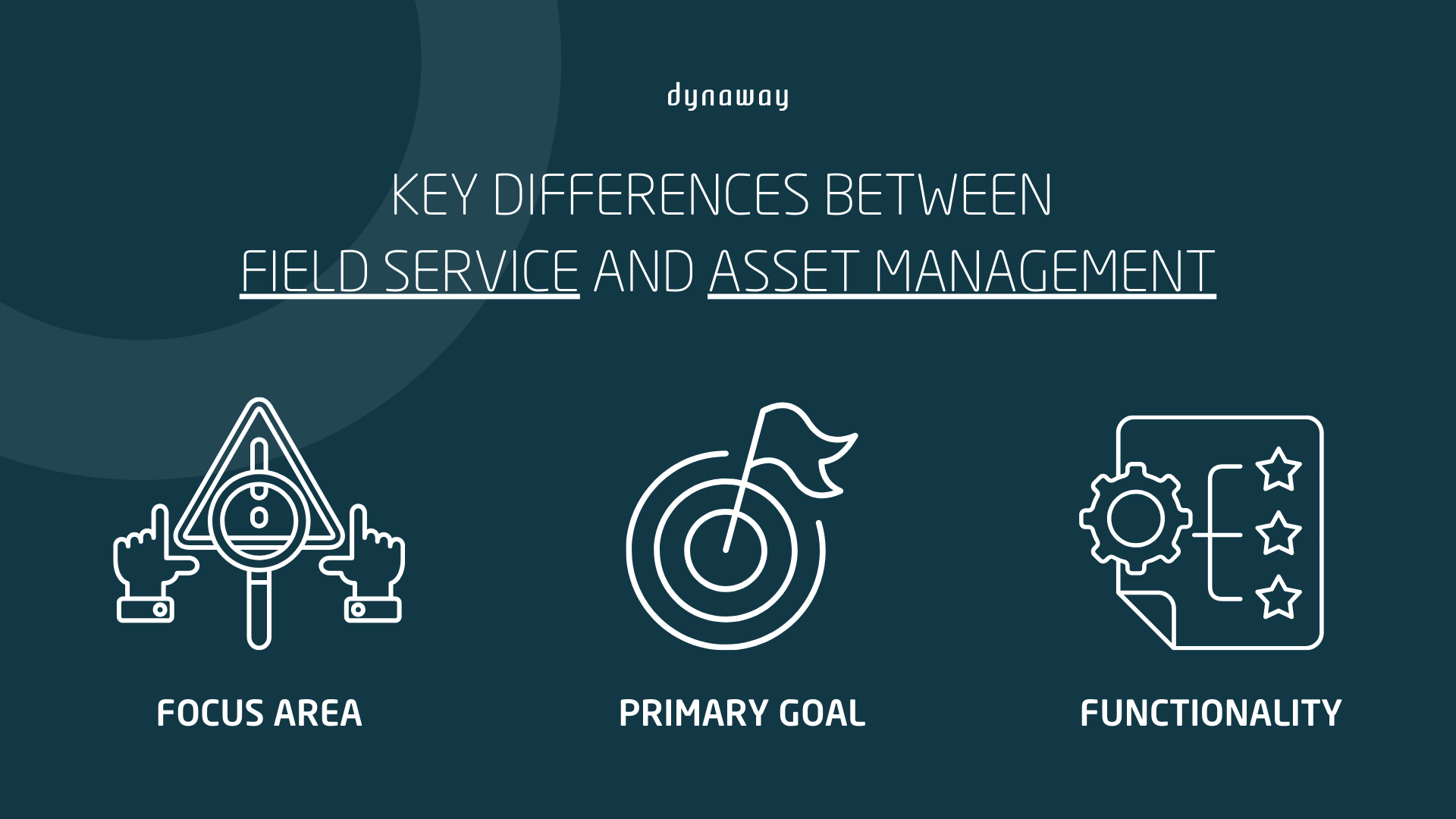
Focus Area
- SM is distinctly service-oriented, concentrating on enhancing field service operations and the efficiency of field personnel. Its domain directly engages with service tasks, aiming to streamline these processes to boost operational efficiency and customer interactions.
- In contrast, AM takes an asset-centric approach. It encompasses a wider spectrum, dedicating its resources to the comprehensive management of an organization's physical assets over its entire lifecycle, from acquisition to disposal. This includes ensuring the assets' optimal health and performance and minimizing downtime.
Primary Goal
The core objectives of these solutions further distinguish them.
- SM is driven by the desire to elevate service delivery efficiency and enhance customer satisfaction. Its measures of success are often seen in the speed and quality of service provided.
- On the other hand, AM's ambition is to extend the life and optimize the performance of assets while concurrently reducing the expenses tied to owning and maintaining these assets. The focus is on long-term asset sustainability, cost-effectiveness, and compliance.
Functionality
Despite some shared functionalities, like scheduling maintenance, the two solutions diverge significantly in their capabilities:
- SM solutions are created to assist in managing and enhancing field operations. They ensure that service tasks are completed efficiently.
- AM solutions, however, offer a comprehensive suite of tools for managing every aspect of an asset's lifecycle, performance, and upkeep, focusing on maintaining asset health and operational readiness.
Choosing the Right Solution for Your Business
When selecting between Field Service Management (FSM) and Enterprise Asset Management (EAM) solutions, it's important to consider the specific needs and goals of your organization.
If you don't know which solution to choose, ask yourself:
"Does my business rely heavily on physical assets like machinery, equipment, or infrastructure?"
"Do I need to ensure regulatory compliance and safety standards in my operations?"
"Am I facing challenges with asset reliability, downtime, or maintenance costs?"
"Is there a need to optimize resource allocation and scheduling for field operations?"
"Do I require real-time visibility into asset performance and service activities?"
By answering these questions, you can gain deeper insights into your business's needs and determine which solution — asset management (AM), service management (SM), or a combination of both — best aligns with your objectives and goals.
If your primary focus is on enhancing field service operations, improving the efficiency of field personnel, and boosting customer interactions, then a Field Service Management solution would be the ideal choice.
On the other hand, if your organization's main goal is to extend the life and optimize the performance of physical assets, while minimizing ownership and maintenance expenses, then an Enterprise Asset Management solution may be more suitable.
Ultimately, the choice between FSM and AM solutions will depend on your organization's specific requirements and objectives. By carefully evaluating your needs and considering the core objectives of each solution, you can select the right tool to support your business operations.
| Asset Management | Service Management & Field Service | |
| Integration vs. Specialisation | AM serves as the foundation of EAM, integrating various aspects of asset lifecycle management. | They are more specialized areas focused on specific aspects of asset-related services. |
| Strategic vs. Operational | AM is often more strategic, focusing on long-term asset value and alignment with organizational goals. | They are more operational, dealing with the day-to-day management of services and field operations. |
| Broad Scope vs. Focused Scope | AM has a broad scope, covering all types of assets across the organization. | SM is more focused on the delivery of services, and FS is specifically concerned with services provided in the field. |
In some cases, integrating both SM and AM solutions can be highly beneficial for organizations. Such an approach allows for a more comprehensive operational overview, ensuring assets are meticulously maintained while also streamlining field service operations for improved efficiency and customer satisfaction. This holistic strategy ensures that organizations can maintain operational excellence across all fronts, from asset management to customer service delivery.
Conclusion
In a nutshell, managing assets and services well is vital for any business to succeed. Knowing the distinctions between asset management (AM) and service management (SM) helps in picking the right tools to make operations smooth and meet company goals.
Remember: Asset management is all about getting the most out of physical assets, while service management focuses on delivering top-notch services to keep customers happy.
Dynaway EAM
If you decide to opt for Asset Management and EAM, keep in mind Dynaway. Our EAM software is seamlessly integrated with Microsoft Dynamics 365, which means your asset management processes seamlessly fit into your existing Dynamics environment.
With Dynaway EAM, you get all your asset data consolidated within Dynamics 365. This integration eliminates the need to switch between different systems and ensures that your team has access to real-time information for making informed decisions quickly.
In addition, our integration with Microsoft Dynamics 365 ensures that your investment is future-proof. As Dynamics evolves, so does Dynaway EAM, keeping your business up-to-date with the latest advancements in technology.
So, why not take the next step towards enhancing your business today with Dynaway?


